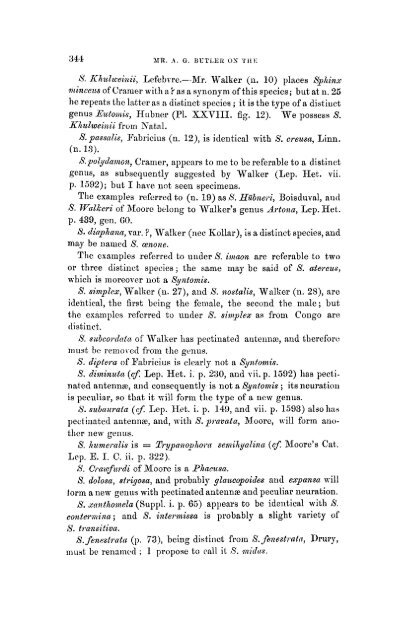Notes on the Lepidoptera of the Family Zygnid, with ... - Wallace Online
Notes on the Lepidoptera of the Family Zygnid, with ... - Wallace Online
Notes on the Lepidoptera of the Family Zygnid, with ... - Wallace Online
You also want an ePaper? Increase the reach of your titles
YUMPU automatically turns print PDFs into web optimized ePapers that Google loves.
34 L MR. 4. Ci. DUTLETL US 'I'll!:<br />
A'. IL'hulzceiki, Lefebrre.--Mr. Walker (11. 10) places Xp1Lin.v<br />
minceus <strong>of</strong> Cranier <strong>with</strong> a P as a syn<strong>on</strong>ym <strong>of</strong> this species; but at 11.25<br />
he repents <strong>the</strong> latter as a distinct species ; it is <strong>the</strong> type <strong>of</strong> a distiuct<br />
genus E'utomis, Hubner (PI. XXVIII. fig. 12). We posses8 X.<br />
Khlweinii from Katal.<br />
X. passalis, Fabricius (n. 12), is identical <strong>with</strong> S. creusa, Linn.<br />
(n. 13).<br />
ky.polydam<strong>on</strong>, Cramer, appears to me to be referable to a distinct<br />
gentis, as subsequently suggested by Walker (Lep. Het. vii.<br />
p. 1592); but I hare not seen specimens.<br />
The examples referred to (n. 19) as X. Hiibizeri, Boisduval, autl<br />
S. Walkeri <strong>of</strong> Moore bel<strong>on</strong>g to Walker's genus Art<strong>on</strong>a, Lep. I-Iet.<br />
p. 439, gen. 60.<br />
8. cliaphana, var. ?, Walker (nee Kollar), is a distiiict species, and<br />
may be iiauied X. cen<strong>on</strong>e.<br />
The examples referred to under X. iina<strong>on</strong> are referable to two<br />
or three distinct species; <strong>the</strong> same may be said <strong>of</strong> X. atereus,<br />
which is moreover not a Xyntomis.<br />
S. simplex, Walker (n. 27), arid X. nostalis, Walker (n. 28), are<br />
identical, <strong>the</strong> first being <strong>the</strong> female, <strong>the</strong> sec<strong>on</strong>d <strong>the</strong> male; but<br />
<strong>the</strong> examples referred to under X. simplex as from C<strong>on</strong>go are<br />
distinct.<br />
S. subeordata <strong>of</strong> Walker has pectinated anteiiiiz, mid <strong>the</strong>refore<br />
must be remot ed from <strong>the</strong> genus.<br />
S. d@tera <strong>of</strong> Pabricius is clearly not a Synfomis.<br />
X. diiminuta (cf. Lep. IIet. i. p. 230, aiid Yii. p. 1592) has pecti-<br />
nat ed antenns, and c<strong>on</strong>sequently is not a Synf<strong>on</strong>zis ; its neuratioii<br />
is peculiar, so that it sill form <strong>the</strong> type <strong>of</strong> a new genus.<br />
S. subaurala (eJ Lep. Het. i. p. 149, and vii. p. 1593) also had<br />
pcct iiiated antennz, and, <strong>with</strong> X. pravata, &loore, N ill form ano-<br />
<strong>the</strong>r new genus.<br />
X. humeralis is = Trypanophora seniihynlina (cJ: Moore's Cat.<br />
Lcp. E. I. C. ii. p. 322).<br />
X. Crazufwdi <strong>of</strong> Moore is a Phacusa.<br />
X. dolosa, sfr{qosa, and probably glaaicopoides and expansa will<br />
form a new genus <strong>with</strong> pectinated antenns and peculiar neurati<strong>on</strong>.<br />
X. x<strong>on</strong>thornela (Suppl. i. p. 65) appears to be identical <strong>with</strong> X.<br />
c<strong>on</strong>teriizina; and S. intermissa is probably a slight variety <strong>of</strong><br />
S. fransitiva.<br />
5'. feneslrata (11. 73), being distinct froin S. fenestratn, Drurg,<br />
IIILIR~ be reiiaincd ; 1 propose to call it S. midus.












